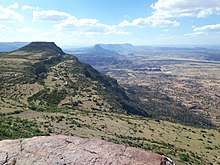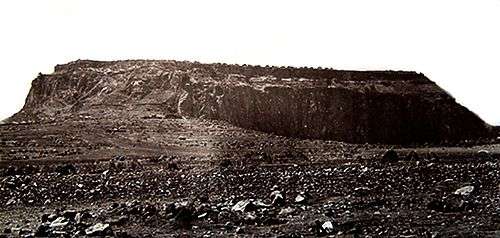Amba (landform)
An Amba (Amharic: አምባ āmbā, Tigrinya: እምባ imbā) is a characteristic landform in Ethiopia. It is a steep-sided, flat-topped mountain, often the site of villages, wells, and their surrounding farmland. Such settlements were frequently located on these amba plateaus because they were very defensible and often virtually inaccessible from the ground.


The original term in Amharic indicates a mountain fortress. Amba Geshen, for example, is a historically significant amba where members of royal families were kept under guard for their safety and to prevent their participation in plots against the sitting emperor. Other noted Ambas include Amba Aradam and Amba Alagi, sites of famous battles during the first and second Italo-Ethiopian Wars. In Tigrinya, the term is "Emba" (also spelled "Imba").
Notable Ambas in Ethiopian History
- Magdala - Emperor Tewodros's last refuge before his defeat and death as a result of the Anglo-Ethiopian War.
- Amba Alagi - Site of 3 Battles, in both Italo-Ethiopian Wars.
- Amba Geshen - A Historic 'Prison' or 'Detention' location for royal family members
- Debre Damo - The name of both an Amba and historic Ethiopian Church.
More Recent Information Regarding Ambas
In 2008, a scientific mission identified on an amba near Harar, the Kundudo, one of just two feral horse populations in Africa.
Sources
- Munro-Hay, Stuart, Ethiopia, the Unknown Land: A Cultural and Historical Guide, Contributor Pamala Taor, Published 2002 by I. B. Tauris, 384 pages, ISBN 1-86064-744-8